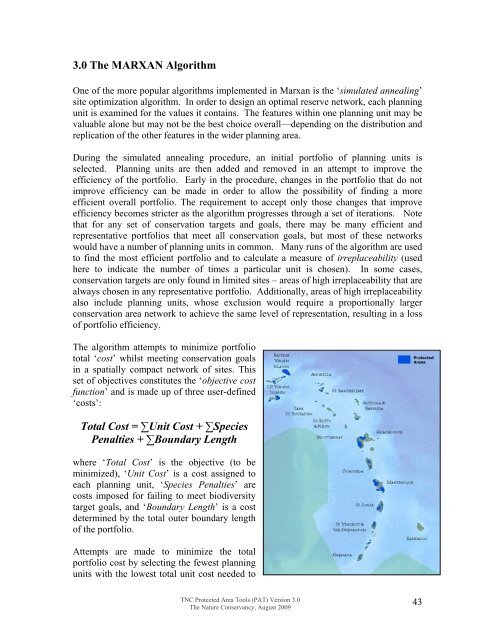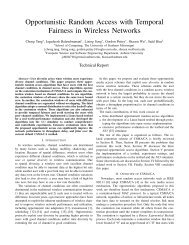Download the Tutorial
Download the Tutorial
Download the Tutorial
Create successful ePaper yourself
Turn your PDF publications into a flip-book with our unique Google optimized e-Paper software.
3.0 The MARXAN AlgorithmOne of <strong>the</strong> more popular algorithms implemented in Marxan is <strong>the</strong> ‘simulated annealing’site optimization algorithm. In order to design an optimal reserve network, each planningunit is examined for <strong>the</strong> values it contains. The features within one planning unit may bevaluable alone but may not be <strong>the</strong> best choice overall—depending on <strong>the</strong> distribution andreplication of <strong>the</strong> o<strong>the</strong>r features in <strong>the</strong> wider planning area.During <strong>the</strong> simulated annealing procedure, an initial portfolio of planning units isselected. Planning units are <strong>the</strong>n added and removed in an attempt to improve <strong>the</strong>efficiency of <strong>the</strong> portfolio. Early in <strong>the</strong> procedure, changes in <strong>the</strong> portfolio that do notimprove efficiency can be made in order to allow <strong>the</strong> possibility of finding a moreefficient overall portfolio. The requirement to accept only those changes that improveefficiency becomes stricter as <strong>the</strong> algorithm progresses through a set of iterations. Notethat for any set of conservation targets and goals, <strong>the</strong>re may be many efficient andrepresentative portfolios that meet all conservation goals, but most of <strong>the</strong>se networkswould have a number of planning units in common. Many runs of <strong>the</strong> algorithm are usedto find <strong>the</strong> most efficient portfolio and to calculate a measure of irreplaceability (usedhere to indicate <strong>the</strong> number of times a particular unit is chosen). In some cases,conservation targets are only found in limited sites – areas of high irreplaceability that arealways chosen in any representative portfolio. Additionally, areas of high irreplaceabilityalso include planning units, whose exclusion would require a proportionally largerconservation area network to achieve <strong>the</strong> same level of representation, resulting in a lossof portfolio efficiency.The algorithm attempts to minimize portfoliototal ‘cost’ whilst meeting conservation goalsin a spatially compact network of sites. Thisset of objectives constitutes <strong>the</strong> ‘objective costfunction’ and is made up of three user-defined‘costs’:Total Cost = ∑Unit Cost + ∑SpeciesPenalties + ∑Boundary Lengthwhere ‘Total Cost’ is <strong>the</strong> objective (to beminimized), ‘Unit Cost’ is a cost assigned toeach planning unit, ‘Species Penalties’ arecosts imposed for failing to meet biodiversitytarget goals, and ‘Boundary Length’ is a costdetermined by <strong>the</strong> total outer boundary lengthof <strong>the</strong> portfolio.Attempts are made to minimize <strong>the</strong> totalportfolio cost by selecting <strong>the</strong> fewest planningunits with <strong>the</strong> lowest total unit cost needed toTNC Protected Area Tools (PAT) Version 3.0The Nature Conservancy, August 200943
















